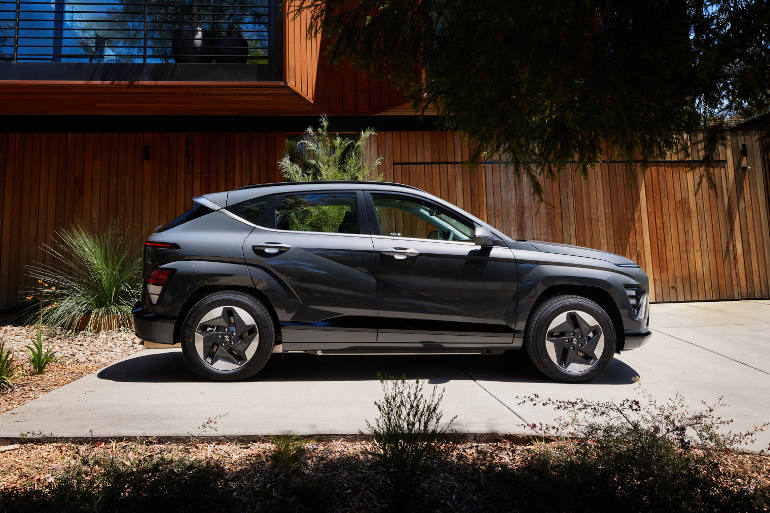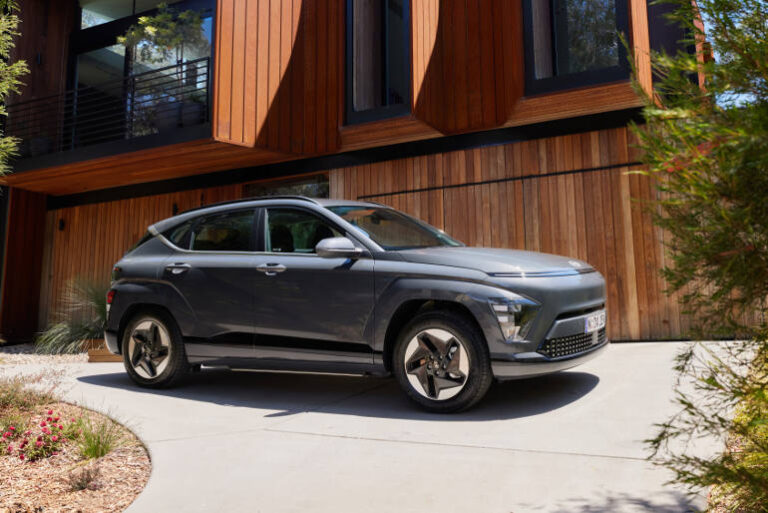Fleet and novated lease vehicles will play an outsized role in Australia’s take up of electric vehicles, thanks in part to fringe-benefits tax exemptions and corporate sector emissions targets.
One of the single most significant new entrants to the landscape for 2024 is the second-generation Hyundai Kona Electric, follow-up to a vehicle that was many people’s first go in an EV.
The new model is bigger and bolder than before, with a futuristic look and two battery options to choose from. It also gives Hyundai a new EV entrant beneath the Ioniq 5 and Ioniq 6.
Of perhaps even more importance, Hyundai Australia understands fleets. It’s not an EV startup like Tesla, and for all that company’s virtues, sometimes a proven relationship is demanded.
Prices remain keen-ish, handily below the FBT exemption threshold meaning reduced leasing costs, though they cannot match the cut-price positioning of rising Chinese models like the $6,000 cheaper BYD Atto 3.
The Standard Range Kona Electric costs $54,000 before on-road costs; and has a 48.6 kWh battery pack powering a 99 kW and 255 Nm motor, front-wheel drive, and a 370 km claimed driving range.
The Extended Range that we drove at the recent media launch costs $58,000 in return for a more powerful 150 kW and 255 Nm motor and bigger 65kWh battery, extending the range to 505 km.
It makes the extra $4,000 seem decidedly reasonable. In fact a total no-brainer, since at the very least it will hold its value better when you need to sell it.
For those who want more luxuries there’s the Extended Range Premium for $68,000, but keep in mind its wider tyres and bigger 19-inch wheels slash the driving range to 444 km.
Press the starter button and twist the shift-by-wire transmission dial on the steering column into Drive, and the Kona Extended Range with the bigger motor has the typical EV instant jolt of power off the line.
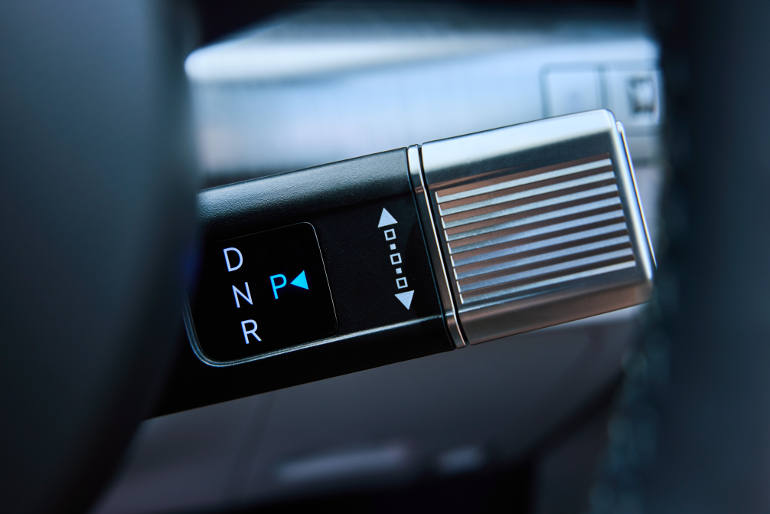
Better yet, Hyundai’s wise decision to dial back the peak torque rating compared to the old model’s e-motor means it no longer torque steers off the line.
The Kona EV offers several degrees of regenerative braking from ‘no resistance’ to ‘heavy resistance’, the latter harvesting more waste energy for the battery, or to power the energy-saving cabin heat pump.
Further upgrades over the old Kona include a higher 10.4 kWh peak AC charging capacity, newfound towing ability of 750 kg with pre-wired trailer braking (enough for a loaded box trailer), and vehicle-to-load (V2L) capability including vehicle-to-vehicle trickle charging with an emergency cable accessory.
On a 100kW DC fast charger it’ll go from 10 to 80% charge in about 45 minutes, while it’ll fill up the battery in around 7-8 hours on an AC wallbox.
EVs are more efficient in stop/start driving, where you can tap into regenerative braking, and less efficiently on highways where you should bank on losing 10-15% range. For instance in a Premium model, the range went from 444km claimed, to 380km on a stint along the Hume Highway.
One thing the Kona Electric does well is handle like a regular combustion vehicle, despite the added weight of the battery. It feels planted, with good handling and a composed and comfortable ride quality, the result of smart tuning.
EVs tend to sound noisier on the road given there’s no engine drone, and the Kona EV does indeed allow some degree of tyre roar when you’re driving on coarse roads. But there’s body sealing and more under-floor insulation, new suspension bushings, and an acoustic windscreen to offset some of this.
On the topic of noise, at low speeds the Kona emits a sound from an external speaker to alert pedestrians
Unlike almost all other EVs, the Kona has a spare tyre. Just a space-saver, but it’s better than a can of sealant with a compressor as we’re seeing so often now and adds comfort on trips into far-flung areas.
The second-gen Kona Electric’s interior is a massive step up even in the base model with cloth seats and hard-wearing but basic cabin plastics. If you like EV cabins that feel ‘normal’, this is for you.
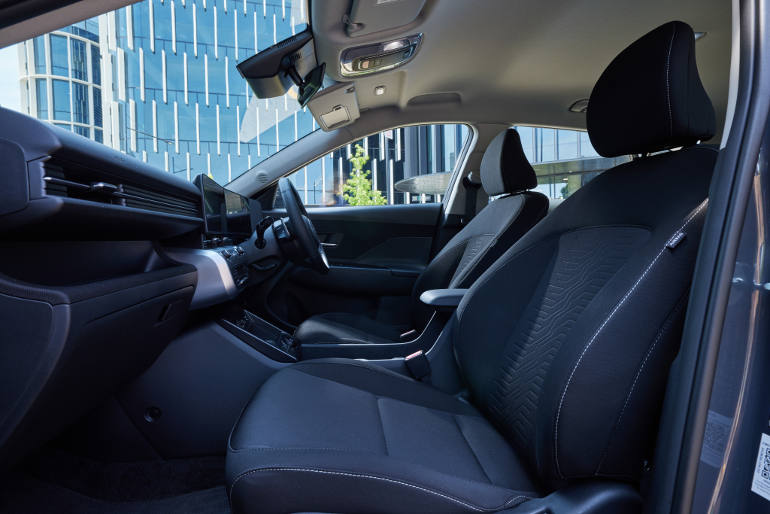
It’s bigger than before for one thing, opening it up to more buyers. There’s 77mm more rear legroom than before, making it roomy enough for four adults, and the boot grows 23% to 407L, or 1241L with the back seats folded.

It’s also much more modern and contemporary with a 12.3-inch touchscreen with over-the-air update capability, Hyundai Bluelink app connectivity, improved natural language-based voice recognition, and a dedicated EV user interface. This is paired in a single frame with a 12.3-inch instrument display.
It’s not quite at Tesla level when it comes to software genius, but it’s a good system with connected satellite-navigation, digital radio, Apple CarPlay and Android Auto, Bluetooth multi-connections, USB-C inputs, and split-screen function.
An array of EV-specific information is provided across the displays, such as driving data, battery level and usage statistics, charging settings, charging station locations, battery conditioning, and V2L use.
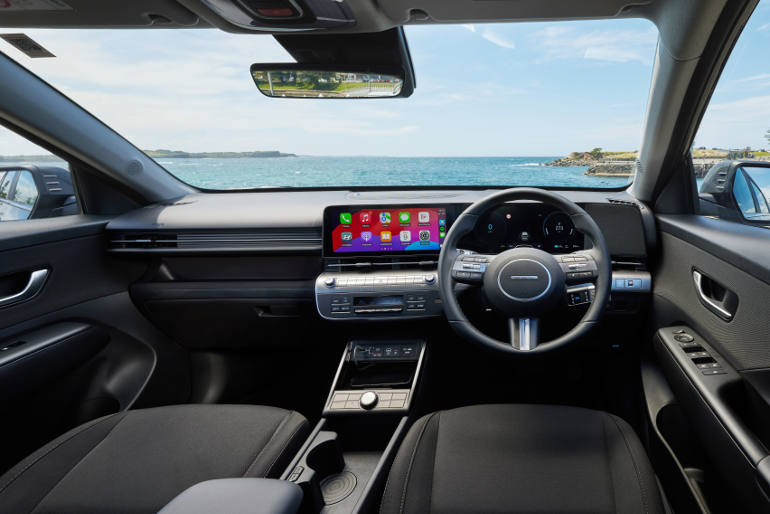
The interior also has a tonne of storage options in the centre tunnel, doors and dash, and the refreshing use of buttons and knobs for the climate controls, drive mode selector etc. instead of screen menus.
As well as getting more space than before, the back seats recline, and come with separate air vents and USB ports. It’s much more family friendly than before, and better positioned between the Venue and Tucson size-wise.
This car also has every driver assist feature and safety system known to man, including: AEB with evasive steering assist, lane-keeping aids with haptic steering wheel feedback, and adaptive cruise control that uses machine learning to figure out your preferred level of aggressiveness over time, and match the speed limit as it changes.
The top-of-the-range model can even be parked forwards or backwards using the key fob, making it a giant remote-controlled car at crawling speed.
It’s not all great though. For example it gets annoying when every time you accidentally go a few clicks over the speed limit, the Kona starts chiming at you. And the driver monitoring system, an infra-red camera that watches for signs of tiredness by monitoring the driver’s face, eyes and head position, is way too sensitive.
I found it would start telling me to pay attention audibly, even when I was doing exactly that. You can switch it off, but not permanently.
However, even with all these features as well as the full suite of airbags including a front-centre ‘bag for side impacts, it only has a four-star ANCAP rating – albeit due to poor scores in Safety Assist and Vulnerable Road User Protection tests, rather than actual occupant protection.
In terms of running costs, Hyundai provides a 5-year warranty with no mileage limit, and an 8-year or 160,000km warranty on the battery. You only need to service it every two years or 30,000km, but each visit is a steep $520.
In terms of spec walk, both of the base Standard and Extended Range variant have 17-inch wheels, a temporary spare, heated side mirrors, LED headlights, rain-sensing wipers, proximity sensing key, cloth seats, dual-zone climate control, a 12..3-inch instrument cluster, and a 12.3-inch centre touchscreen with app connectivity, connected sat-nav, OTA capability, six speakers, and voice control.
The $10,000 more expensive Premium adds a 3D surround-view camera, blind-spot view monitor in the instrument cluster, remote control, 19-inch wheels, solar control glass and an acoustic windscreen, better LED headlights, a power tailgate, upgraded Bose audio, leather seats with heating and ventilation, and a sunroof.
All up it’s a quality bit of kit, this Kona Electric. The $58,000 Extended Range in base trim is the obvious one to buy for fleets, with its funky design and modern interior maintained, the longest driving range, and more favourable Whole of Life Cost.
